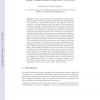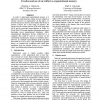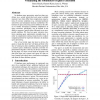3616 search results - page 3 / 724 » Conditional Memory Ordering |
FM
2009
Springer
13 years 8 months ago
2009
Springer
Abstract. Explicit state methods have proven useful in verifying safetycritical systems containing concurrent processes that run asynchronously and communicate. Such methods consis...
HICSS
2003
IEEE
14 years 4 months ago
2003
IEEE
In order to understand organizational memory, it is important to understand how things become adopted as memory resources in organizations. In this paper, we describe the genesis ...
SPAA
2009
ACM
14 years 11 months ago
2009
ACM
Transactional memory (TM) is a promising approach for designing concurrent data structures, and it is essential to develop better understanding of the formal properties that can b...
CGO
2009
IEEE
14 years 5 months ago
2009
IEEE
—Most research into high-performance software transactional memory (STM) assumes that transactions will run on a processor with a relatively strict memory model, such as Total St...
CIDR
2009
13 years 12 months ago
2009
In database query processing, actual run-time conditions (e.g., actual selectivities and actual available memory) very often differ from compile-time expectations of run-time cond...



